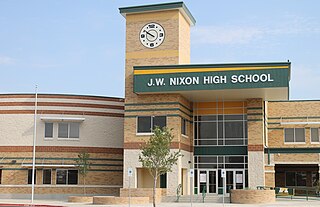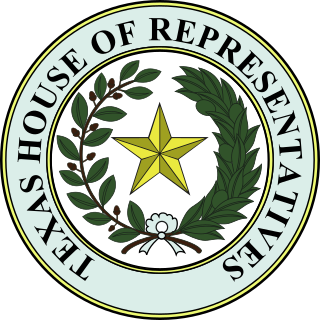
Webb County is a county located in the U.S. state of Texas. As of the 2010 census, the population was 250,304. Its county seat is Laredo. The county was named after James Webb, who served as Secretary of the Treasury, Secretary of State, and Attorney General of the Republic of Texas, and later judge of the United States District Court following the admission of Texas to statehood. By area, Webb County is the largest county in South Texas and the sixth largest in the state.

Laredo is a city in and the county seat of Webb County, Texas, United States, on the north bank of the Rio Grande in South Texas, across from Nuevo Laredo, Tamaulipas, Mexico. Laredo has the distinction of flying seven flags. Founded in 1755, Laredo grew from a village to the capital of the brief Republic of the Rio Grande to the largest inland port on the Mexico–United States border. Laredo's economy is based on international trade with Mexico. Many major transportation companies have a facility in Laredo. The city is on the southern end of I-35 which makes it close to the manufacturers in northern Mexico. It has four international bridges and one railway bridge.

Texas A&M International University, often referred to as TAMIU, is a public, co-educational, state-supported university located in Laredo, Texas. The university has a modern campus on a 300-acre (1.2 km2) site in Laredo, Texas. It is a Member of the Texas A&M University System which is one of the largest systems of higher education in the nation. Located in Laredo, Texas, a crossroads of culture and commerce, TAMIU is a major regional educational institution of choices in the State's fastest-growing demographic area and home to over 7500+ students each academic semester. TAMIU offers over 70 undergraduate, graduate or doctoral degrees in the arts and sciences, business administration, and nursing in the four colleges of the University.

Lane Community College is a public two-year college in Eugene, Oregon, United States with additional facilities in downtown Eugene, Florence, Cottage Grove, and the Lane Aviation Academy at Eugene Airport. Lane serves more than 26,000 credit and non-credit students annually in a 5,000 square-mile (~8047 km2) service district, including most of Lane County as well as individual school districts in Benton, Linn, and Douglas counties.

Laredo Independent School District is a public school district based in Laredo in Webb County, Texas, United States. The district serves the south central portion of Laredo. In 2009, LISD was rated "academically acceptable" by the Texas Education Agency.

Joseph W. Nixon High School is a public high school located in South Texas. It was built in 1964 as the second high school in Laredo, Texas. The original high school in Laredo is Raymond & Tirza Martin High School, previously known as Laredo High School. Both are part of the Laredo Independent School District (LISD).
Raymond & Tirza Martin High School, known as Martin High School, is a secondary institution of learning located in the Laredo Independent School District in Laredo, Texas, United States. Grades 9th through 12th are taught there. It serves students living in central Laredo. The school is adjacent to the Laredo Civic Center.

William N. "Billy" Hall, Jr., was a Democratic member of the Texas House of Representatives from Laredo, Texas, who served in District 57 from 1973 to 1987. He was subsequently the county treasurer of Webb County from 1995 until his death.
Julio Arnoldo Garcia, Sr., was a prominent attorney from Laredo, Texas, defined by a headline writer as a "legal lion" known for his passion, shrewdness, and theatrics in the courtoom." Garcia served from 1981 to 1988 as the Democratic district attorney of the 49th Judicial District of heavily Hispanic South Texas. The district then included Webb, Zapata, Dimmit, and Jim Hogg counties, but it is now confined to Webb and Zapata counties.

Joseph Claude Martin, Jr., known as Pepe Martin or Jose Martin or Joe Martin, was from 1954 to 1978 the mayor of his native Laredo, Texas. He was known as el patron, a term which refers to a political boss in South Texas who performs small favors for the public in return for absolute political loyalty.

Esther Gonzalez-Arroyo Buckley was an educator in Laredo, Texas, USA, who from 1983 to 1992 was one of the eight members of the United States Commission on Civil Rights. She was appointed to the board by U.S. President Ronald W. Reagan.
Louis Henry Bruni is a businessman, rancher, politician, and the scion of a pioneer family in his native Laredo, Texas. From 2003 to 2006, he was the elected administrative County Judge of Webb County in South Texas.
Charles Robert Borchers, known as Charlie Borchers, was a lawyer from Laredo, Texas, who served from 1973 to 1980 as the district attorney of the 49th Judicial District, which then included Dimmit, Webb, and Zapata counties in South Texas.
Roger Lewis Worsley is a retired college administrator who from 1985 to 1995 was the president of Laredo Community College in Laredo, Texas, and from 1996 to 2005 the chancellor of Southern Arkansas University Tech in Camden, Arkansas.

Domingo Arechiga Jr., was an Hispanic educator who from 1974 to 1985 was the president of Laredo Community College, then Laredo Junior College in Laredo, Texas.

Ray A. Laird was from 1960 to 1974 the president of Laredo Community College in Laredo, Texas, United States. Prior to 1960, he was the dean of LCC, then known until 1993 as Laredo Junior College. The two-year institution is located near the Rio Grande.
Ray Marvin Keck, III is the former president of Texas A&M University - Commerce. Prior to this position he was fifth president of Texas A&M International University, a four-year institution with certain graduate programs as well in Laredo, Texas, USA, a post to which he was initially appointed effective September 1, 2001. He is also a distinguished organist.

Juan Leandro Maldonado was a higher education administrator who served as the sixth president of Laredo Community College in Laredo in Webb County in South Texas, USA. In August 2007, upon the sudden retirement of Ramón H. Dovalina, Maldonado assumed the LCC presidency. Maldonado retired from LCC effective August 1, 2016.























